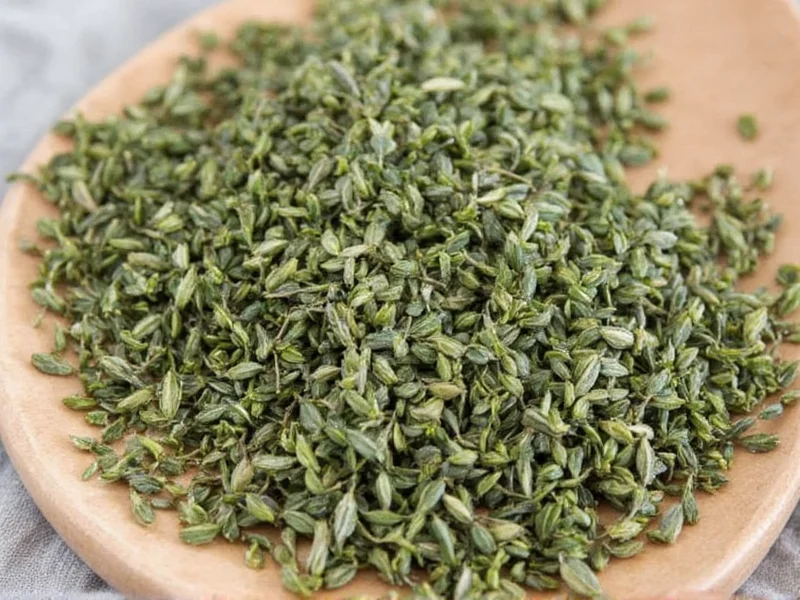When substituting dried thyme for fresh thyme in recipes, use a 1:3 ratio—1 teaspoon of dried thyme equals 1 tablespoon of fresh thyme. Dried thyme is more concentrated because the dehydration process removes water while intensifying essential oils, making it roughly three times stronger than fresh. This conversion applies to most savory dishes including soups, stews, roasted meats, and tomato-based sauces.
Understanding herb substitutions is essential for consistent cooking results. Fresh and dried thyme differ significantly in flavor concentration due to their moisture content. Fresh thyme contains about 85% water, while dried thyme has most moisture removed, concentrating its essential oils and flavor compounds. This fundamental difference explains why direct 1:1 substitution leads to disappointing results—either overpowering bitterness from too much dried thyme or lack of herbal notes when using insufficient amounts.
Understanding Thyme Conversion Ratios
The standard conversion ratio exists for scientific reasons. When herbs dry, their cellular structure breaks down, releasing and concentrating volatile aromatic compounds. Thyme's primary flavor components—thymol and carvacrol—become more potent as water evaporates. Food science research confirms dried herbs generally contain three to four times the flavor concentration of fresh counterparts.
| Measurement | Fresh Thyme | Dried Thyme |
|---|---|---|
| Basic Ratio | 3 parts | 1 part |
| Teaspoon Equivalent | 1 tablespoon | 1 teaspoon |
| Cup Measurement | 3/4 cup | 1/4 cup |
| Pinch Equivalent | 1 sprig | 1/4 teaspoon |
Practical Substitution Guidelines
Successful substitution requires more than simple measurement conversion. Consider these factors when replacing fresh thyme with dried:
Timing Matters
Add dried thyme early in cooking to allow rehydration and flavor distribution. Unlike fresh thyme, which can be added toward the end, dried thyme needs 15-20 minutes simmering time to fully release its flavors. For quick-cooking dishes like sautés, steep dried thyme in a small amount of warm broth or oil for 5 minutes before adding to the pan.
Dish Type Considerations
Not all recipes follow the standard ratio perfectly:
- Long-simmered dishes (stews, braises): Use 3/4 of the recommended dried amount, as flavors concentrate during cooking
- Delicate dishes (fish, egg dishes): Reduce dried thyme by 25% to prevent overpowering subtle flavors
- Dry rubs: Use equal parts dried thyme to other dried herbs, as moisture isn't a factor
- Vinaigrettes: Steep dried thyme in warm oil first, then strain before emulsifying
Alternative Substitutes When Dried Thyme Isn't Available
If you lack both fresh and dried thyme, these alternatives work in specific contexts:
| Substitute | Best For | Conversion Ratio | Flavor Notes |
|---|---|---|---|
| Oregano | Mediterranean dishes, tomato sauces | 1:1 dried oregano to dried thyme | More pungent, less floral |
| Marjoram | Roasted vegetables, poultry | 1:1 dried marjoram to dried thyme | Sweeter, milder profile |
| Herbes de Provence | French cuisine, roasted meats | 1.5:1 blend to dried thyme | Complex herbal notes |
| Italian Seasoning | Pasta sauces, pizza | 1.5:1 blend to dried thyme | Balanced herb mixture |
Maximizing Dried Thyme Flavor
Proper handling significantly impacts dried thyme's performance as a fresh substitute:
Reviving Stale Dried Thyme
Dried thyme loses potency after 6-12 months. Test freshness by rubbing between fingers—it should release strong aroma. To revive older thyme:
- Toast lightly in dry pan for 30 seconds
- Crush between palms before measuring
- Steep in warm liquid for 5 minutes before use
Storage Best Practices
Preserve dried thyme quality by storing in airtight containers away from light and heat. Glass jars in dark pantries maintain potency longest. Avoid storing near stove or oven, as heat accelerates flavor degradation. Properly stored dried thyme retains optimal flavor for 1-2 years.
Recipe-Specific Substitution Tips
These practical examples demonstrate proper fresh-to-dried thyme conversion in common dishes:
Beef Stew Conversion
Original recipe: 3 tablespoons fresh thyme
Substitution: 1 tablespoon dried thyme added with broth
Pro tip: Bloom dried thyme in 2 tablespoons tomato paste before adding liquids
Roasted Chicken Adjustment
Original recipe: 2 tablespoons fresh thyme under skin
Substitution: 2 teaspoons dried thyme mixed with 1 teaspoon olive oil
Pro tip: Add half the dried thyme under skin, half to roasting pan
Tomato Sauce Modification
Original recipe: 1 tablespoon fresh thyme added in last 10 minutes
Substitution: 1 teaspoon dried thyme added at beginning of simmer
Pro tip: Finish with fresh parsley to compensate for lost fresh herb brightness
Common Substitution Mistakes to Avoid
Cooks frequently make these errors when substituting dried for fresh thyme:
- Using equal measurements - results in weak flavor (too little dried) or overpowering bitterness (too much dried)
- Adding dried thyme too late - insufficient time to rehydrate and distribute flavor
- Not adjusting for dish moisture content - drier dishes need slightly more dried herb
- Using old, stale dried thyme - requires up to 50% more quantity for equivalent flavor











 浙公网安备
33010002000092号
浙公网安备
33010002000092号 浙B2-20120091-4
浙B2-20120091-4